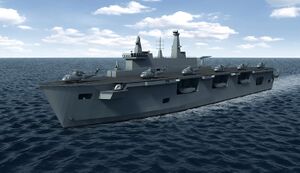Pacific-Class Landing Helicopter Dock
 Pacific-Class LHD
| |
| Class overview | |
|---|---|
| Name: | Pacific-Class Landing Helicopter Dock |
| Operators: | Royal Apilonian Navy |
| Preceded by: | Ocean-Class |
| Built: | 2017 - Present |
| In service: | 2019 - Present |
| In commission: | 2020 - Present |
| Planned: | 9 |
| Building: | 6 |
| Completed: | 3 |
| Active: | 3 |
| General characteristics | |
| Type: | Landing Helicopter Dock (LHD) |
| Displacement: | 23,000 Tonnes |
| Length: | 210m |
| Beam: | 32m |
| Draft: | 6m |
| Propulsion: |
list error: <br /> list (help) |
| Speed: | 22knots |
| Range: | 7,000 Nautical Miles |
| Troops: | 800 |
| Complement: | Ship's Company: 300 Officers and Ratings |
| Sensors and processing systems: |
list error: <br /> list (help) |
| Electronic warfare & decoys: | Sea Gnat Decoy System |
| Armament: |
2x 40mm Autocannons 2x 30mm CIWS |
| Aircraft carried: | 6x Medium Helicopters (Merlin) |
| Aviation facilities: | Hanger Deck for 6x Medium helicopters |
The Pacific-Class Landing Helicopter Dock is a class of amphibious assault vessel owned and operated by the Royal Apilonian Navy, designed to replace the aging, and built-to-commercial standards, Ocean-Class amphibious assault vessel which was the backbone of the RAN’s amphibious capability. The Pacific-Class is an evolution of it’s predecessor, whilst also incorporating some of the capability offered by a landing platform dock, and is an initiative by the Admiralty to determined the practicality of replacing both its legacy LHA and LPD designs with one ship. This is in keeping with the development of a modern amphibious doctrine for the Apilonian naval service, in which the priority is getting Marines ashore to secure a beachhead or airport to allow additional forces to be deployed. ‘In-Area’, that is any region that the Kingdom has an enduring colonial presence, such as the Mediterranean, Persian Gulf and, more recently, East Africa, this is achieved by RAMC ‘garrisons’, which are deployed into enemy shores by landing-ship transport. ‘Out-of-Area’, that is any region that the Kingdom does not have an enduring colonial presence but may still have interests, the greater distances associated with this mean that these operations would have to be supported by directly from the host ship. Given that a landing force deployed by a Pacific-Class LHD would not be any bigger than one deployed by LST, the key difference is the prolonged support the LHD can provide to its landing force.
Design
Unlike the smaller, regional amphibious capability provided by the forward-deployed Marine Garrisons and their Landing Ship Transports, the Pacific-Class is designed to undertake Out-Of-Area contingency (OAC) operations, in which it arrives quickly into an area and sustain operations at sea for prolonged period in support of a battalion (commando) sized landing force ashore. In terms of amphibious capabilities, the Pacific-Class landing helicopter dock includes a fully enclosed floodable well dock with capacity for two LCAC hovercraft or four LCU landing craft, as well as a large flight deck that can accommodate the simultaneous operation of six helicopters, all of which can be accommodated and maintained in an integral hanger deck, as can over a hundred vehicles in several vehicle decks. The Pacific-Class is capable of supporting prolonged amphibious operations, containing storage space for approximately 250 tonnes of stores an ammunition, and a medical facility including two operating theatres. The Pacific-Class is also capable of extensive re-supply, both at sea and alongside, but also for rapid embarkation of a military force via both stern ramp and side rangs, as well as a vehicle ramp directly to the hanger deck.
The Pacific-Class is also designed to serve as a planning and operations management platform for shore operations; equipped with well-equipped operations spaces and a combat system, tailored to RAN and RAMC requirements and weapons fit. In addition, the state of the art integrated bridge system, advanced sensors and communications allow the Pacific-Class to serve as a command centre for the entire amphibious force.